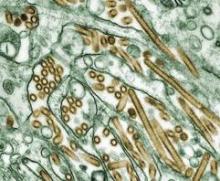User login
SAN FRANCISCO – The pathogenic avian influenza A(H5N1) virus remains entrenched in poultry in many countries and is unlikely to be eradicated, according to Dr. Malik Peiris.
"Over the past 15 years the virus has spread through Asia and to part of Africa. Even this year there have been poultry outbreaks in about nine countries, especially in Egypt but also in Asia and Indonesia," said Dr. Peiris, director of the Center of Influenza Research at the University of Hong Kong. "That, I think, is the real cause for concern."
So far, human disease has been uncommon, but the potential for human exposure to H5N1 is massive, he said. The reasons for viral spread are multifactorial, including the prevalence of backyard flocks of poultry and game birds, which are extremely common in parts of Asia, and the fact that the virus can infect ducks. "These ducks are moved from paddy field to paddy field," he said. "They graze on fallen rice in these paddy fields, and they move the virus without any ill effect to themselves. Live poultry markets are also a reservoir and amplifier. Some lineages of this virus can be moved long distances through migration of wild birds, but it is not clear whether wild birds are a true reservoir of this virus."
To date, Dr. Peiris said, 608 human cases of H5N1 infection have been reported from 15 countries in Asia and Africa. Of these, 359 (59%) have been fatal. The incubation period is 2-3 days, and the virus presents as severe viral pneumonia. "It’s rapidly progressing in previously healthy younger persons," he said. "It’s not the type of pneumonia [caused by] complications of influenza that you see with typical seasonal flu, which is at the extremes of age and is often associated with secondary bacterial superinfection. These are perfectly healthy people."
Virus clades from Indonesia seem to carry the greatest severity, Dr. Peiris said, followed by clades from the Middle East and those from other parts of Asia. There appears to be lower mortality among affected children under age 5 and among patients who receive oseltamivir treatment within 2 days of symptom onset.
"The virus strains are generally sensitive to oseltamivir, though different clades have a different range of sensitivity," Dr. Peiris said at the annual Interscience Conference on Antimicrobial Agents and Chemotherapy. "There are cases where antiviral resistance has been detected, with adverse outcomes."
According to World Health Organization guidelines published in 2007, "modified regimens of oseltamivir treatment, including twofold higher dosage, longer duration, and, possibly, combination therapy with amantadine or rimantadine (in countries where A(H5N1) viruses are likely to be susceptible to amantadines), may be considered on a case by case basis, especially in patients with pneumonia or progressive disease."
According to Dr. Peiris, data on this approach "are limited, but observational data suggest that a higher dose of oseltamivir is not associated with lower mortality."
While some experts argue that H5N1 viruses are inherently unable to transmit from human to human, two recent studies of ferrets suggest that airborne transmission is possible (Science 2012;336:1534-41 and Nature 2012;486:420-8). "While combinations of mutations are required for acquisition of mammalian transmissibility, some of these are individually present in some field isolates of H5N1 viruses, highlighting the need for enhanced and continued vigilance," Dr. Peiris noted.
The H5N1 virus "has diversified genetically and antigenically over the years," he said. "This is the challenge that we face in developing a vaccine for H5N1."
The conference was sponsored by the American Society for Microbiology. Dr. Peiris disclosed that he is a scientific adviser for Crucell and is a consultant for GlaxoSmithKline.
SAN FRANCISCO – The pathogenic avian influenza A(H5N1) virus remains entrenched in poultry in many countries and is unlikely to be eradicated, according to Dr. Malik Peiris.
"Over the past 15 years the virus has spread through Asia and to part of Africa. Even this year there have been poultry outbreaks in about nine countries, especially in Egypt but also in Asia and Indonesia," said Dr. Peiris, director of the Center of Influenza Research at the University of Hong Kong. "That, I think, is the real cause for concern."
So far, human disease has been uncommon, but the potential for human exposure to H5N1 is massive, he said. The reasons for viral spread are multifactorial, including the prevalence of backyard flocks of poultry and game birds, which are extremely common in parts of Asia, and the fact that the virus can infect ducks. "These ducks are moved from paddy field to paddy field," he said. "They graze on fallen rice in these paddy fields, and they move the virus without any ill effect to themselves. Live poultry markets are also a reservoir and amplifier. Some lineages of this virus can be moved long distances through migration of wild birds, but it is not clear whether wild birds are a true reservoir of this virus."
To date, Dr. Peiris said, 608 human cases of H5N1 infection have been reported from 15 countries in Asia and Africa. Of these, 359 (59%) have been fatal. The incubation period is 2-3 days, and the virus presents as severe viral pneumonia. "It’s rapidly progressing in previously healthy younger persons," he said. "It’s not the type of pneumonia [caused by] complications of influenza that you see with typical seasonal flu, which is at the extremes of age and is often associated with secondary bacterial superinfection. These are perfectly healthy people."
Virus clades from Indonesia seem to carry the greatest severity, Dr. Peiris said, followed by clades from the Middle East and those from other parts of Asia. There appears to be lower mortality among affected children under age 5 and among patients who receive oseltamivir treatment within 2 days of symptom onset.
"The virus strains are generally sensitive to oseltamivir, though different clades have a different range of sensitivity," Dr. Peiris said at the annual Interscience Conference on Antimicrobial Agents and Chemotherapy. "There are cases where antiviral resistance has been detected, with adverse outcomes."
According to World Health Organization guidelines published in 2007, "modified regimens of oseltamivir treatment, including twofold higher dosage, longer duration, and, possibly, combination therapy with amantadine or rimantadine (in countries where A(H5N1) viruses are likely to be susceptible to amantadines), may be considered on a case by case basis, especially in patients with pneumonia or progressive disease."
According to Dr. Peiris, data on this approach "are limited, but observational data suggest that a higher dose of oseltamivir is not associated with lower mortality."
While some experts argue that H5N1 viruses are inherently unable to transmit from human to human, two recent studies of ferrets suggest that airborne transmission is possible (Science 2012;336:1534-41 and Nature 2012;486:420-8). "While combinations of mutations are required for acquisition of mammalian transmissibility, some of these are individually present in some field isolates of H5N1 viruses, highlighting the need for enhanced and continued vigilance," Dr. Peiris noted.
The H5N1 virus "has diversified genetically and antigenically over the years," he said. "This is the challenge that we face in developing a vaccine for H5N1."
The conference was sponsored by the American Society for Microbiology. Dr. Peiris disclosed that he is a scientific adviser for Crucell and is a consultant for GlaxoSmithKline.
SAN FRANCISCO – The pathogenic avian influenza A(H5N1) virus remains entrenched in poultry in many countries and is unlikely to be eradicated, according to Dr. Malik Peiris.
"Over the past 15 years the virus has spread through Asia and to part of Africa. Even this year there have been poultry outbreaks in about nine countries, especially in Egypt but also in Asia and Indonesia," said Dr. Peiris, director of the Center of Influenza Research at the University of Hong Kong. "That, I think, is the real cause for concern."
So far, human disease has been uncommon, but the potential for human exposure to H5N1 is massive, he said. The reasons for viral spread are multifactorial, including the prevalence of backyard flocks of poultry and game birds, which are extremely common in parts of Asia, and the fact that the virus can infect ducks. "These ducks are moved from paddy field to paddy field," he said. "They graze on fallen rice in these paddy fields, and they move the virus without any ill effect to themselves. Live poultry markets are also a reservoir and amplifier. Some lineages of this virus can be moved long distances through migration of wild birds, but it is not clear whether wild birds are a true reservoir of this virus."
To date, Dr. Peiris said, 608 human cases of H5N1 infection have been reported from 15 countries in Asia and Africa. Of these, 359 (59%) have been fatal. The incubation period is 2-3 days, and the virus presents as severe viral pneumonia. "It’s rapidly progressing in previously healthy younger persons," he said. "It’s not the type of pneumonia [caused by] complications of influenza that you see with typical seasonal flu, which is at the extremes of age and is often associated with secondary bacterial superinfection. These are perfectly healthy people."
Virus clades from Indonesia seem to carry the greatest severity, Dr. Peiris said, followed by clades from the Middle East and those from other parts of Asia. There appears to be lower mortality among affected children under age 5 and among patients who receive oseltamivir treatment within 2 days of symptom onset.
"The virus strains are generally sensitive to oseltamivir, though different clades have a different range of sensitivity," Dr. Peiris said at the annual Interscience Conference on Antimicrobial Agents and Chemotherapy. "There are cases where antiviral resistance has been detected, with adverse outcomes."
According to World Health Organization guidelines published in 2007, "modified regimens of oseltamivir treatment, including twofold higher dosage, longer duration, and, possibly, combination therapy with amantadine or rimantadine (in countries where A(H5N1) viruses are likely to be susceptible to amantadines), may be considered on a case by case basis, especially in patients with pneumonia or progressive disease."
According to Dr. Peiris, data on this approach "are limited, but observational data suggest that a higher dose of oseltamivir is not associated with lower mortality."
While some experts argue that H5N1 viruses are inherently unable to transmit from human to human, two recent studies of ferrets suggest that airborne transmission is possible (Science 2012;336:1534-41 and Nature 2012;486:420-8). "While combinations of mutations are required for acquisition of mammalian transmissibility, some of these are individually present in some field isolates of H5N1 viruses, highlighting the need for enhanced and continued vigilance," Dr. Peiris noted.
The H5N1 virus "has diversified genetically and antigenically over the years," he said. "This is the challenge that we face in developing a vaccine for H5N1."
The conference was sponsored by the American Society for Microbiology. Dr. Peiris disclosed that he is a scientific adviser for Crucell and is a consultant for GlaxoSmithKline.
EXPERT ANALYSIS FROM THE ANNUAL INTERSCIENCE CONFERENCE ON ANTIMICROBIAL AGENTS AND CHEMOTHERAPY


